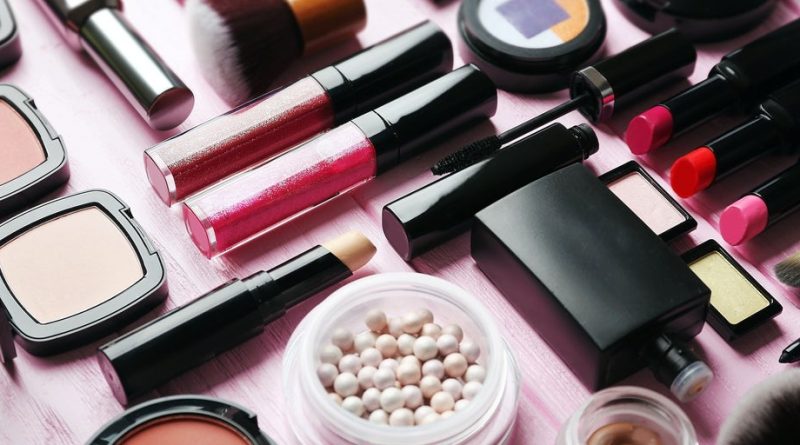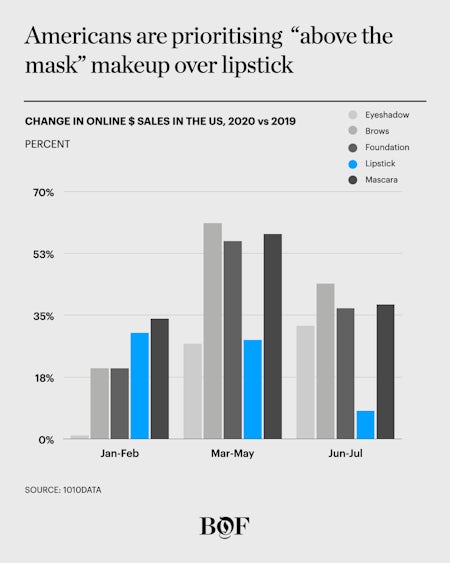What’s Selling In Beauty Right Now | The Business of Beauty
NEW YORK, United States — At the start of the pandemic, consumer spending within the beauty category instantly shifted. Neon makeup was out, dewy skin was in. Salons were closed, so demand for at home hair colour and DIY manicure treatments skyrocketed. With everyone stuck at home, fancy beauty-tech gadgets were a hot commodity, and sales of luxury vibrators were booming.
But much has changed since March. For one, consumer spending has rebounded. In the US, combined spending across sectors is down 8.3 percent since the start of the year, 1010data shows, a significant recovery from declines of 40 percent five months ago.
Plus, salons and spas are slowly reopening across Europe and the US, social interaction is ramping up, and increasing numbers are returning to a work office environment, even if part-time.
So, have beauty spending patterns begun to shift again too?
The vibrator boom may be on the wane (sex tech sales at Cult Beauty were up 80 percent year-on-year in April; in July, the category was down to 15 percent year-on-year growth) but many of the trends that emerged early in the pandemic have only grown stronger. Some new ones can be added to the list as well.
“To a large degree, the way people live has not gone back to pre-Covid [patterns]. And that has driven a lot of persistence within current trends,” said Andy Mantis, head of data insights at 1010data, an analytical intelligence firm that analyses debit and credit card transactions in the US.
The Skincare Sales Surge Rolls On
Pre-coronavirus, the skincare sector was thriving. Global sales grew 6.4 percent last year, according to Euromonitor International. Throughout the pandemic, the trend has continued, at makeup’s expense.
“The shift in category [we saw at the start of the pandemic] has persisted. It’s about skincare, with an added emphasis on things like all natural, or cruelty free,” said Mantis.
In the first half of 2020, L’Oréal’s saw skincare sales up 1.1 percent, while makeup declined 28 percent. In Estée Lauder’s most recent quarter, sales of skincare were up 3 percent, while makeup fell 61 percent.
At beauty website Cult Beauty, lips was the only category to have made a loss, with sales down 10 percent year-on-year, while skin care continues to boom. In March, sales were up 157 percent year-on-year. Five months on, they’re still up 125 percent.
It’s about skincare, with an added emphasis on things like all natural, or cruelty free
During the early 2000s recession, Estée Lauder Chairman Leonard Lauder coined the term “the lipstick index,” the theory that a tube of lipstick was an affordable luxury people would splurge on, no matter how bad the economy. During a pandemic, however, when stay at home orders and masks come into play, lipstick hasn’t proven the most reliable economic indicator.
“Somebody was asking me if the lipstick index is finished,” said Estée Lauder Chief Executive Fabrizio Freda on an August 20 earnings call. “Because of Covid, lipstick was not the right category to indicate that… The lipstick index has been substituted by the moisturising index, but the concept of index is still there.”
In the US, half of the top 20 best-selling beauty products sold online in July were skincare products, according to 1010data. Hit products range from Neutrogena makeup remover to alcohol-free rose petal facial toner, to cruelty-free moisturising cream, Mantis said.
Cult Beauty shoppers are also searching for sleep aids and acne solutions. Coming into summer, sunscreen and tanning saw a boost, with the SPF and self-tanning category growing 19 percent month-on-month.
Don’t Count Out Makeup Yet
Spending on makeup may be declining, but it hasn’t completely dried up.
“It’s more nuanced than just saying makeup is down,” said Alexa Inge, co-founder of Cult Beauty. “They’re not doing these elaborate makeup routines — because that glam look just feels so discordant with the day we’re in — but elevating the look of healthy skin, healthy being the operative word.”
They’re elevating the look of healthy skin, healthy being the operative word.
The site has seen shoppers swap colourful eyeshadow palettes and contouring kits for complexion-focused products, like natural palettes (Charlotte Tilbury’s Pillow Talk palettes continue to perform, said Inge) and tinted moisturisers, as well as lash care products.
As lockdowns ease and people are venturing outside the house wearing masks, they’re investing in makeup products to enhance what people can see: their eyes. Americans, for example, are spending 20 percent more on mascara than they did a year ago, 1010data shows. At Cult Beauty, eye makeup sales are up 9 percent month-on-month. Huda’s Legit Lashes Mascara is particularly popular.
Going forward, L’Oréal is betting on “above the mask” makeup and complexion products that will withstand any mask friction.
“Obviously, when you can’t see the lips, eyes are super important,” said L’Oréal chairman Jean-Paul Agon on an August 1 earnings call. “We want to develop very strongly the makeup for eye or foundation or stay-on foundations.”
The DIY Beauty Boom
With salons and spas closed, trips to the salon to colour hair, get waxed, or enjoy a manicure and pedicure were off the table. It saw a surge in interest in at-home beauty treatments in March and April, as regular salon-goers were anxious to maintain luscious locks and polished nails.
“The beauty consumer is more self-sufficient than ever before,” said Erin Schmit, beauty analyst at Coresight Research. Even as salons open, “this trend is still continuing,” she said.
Unsurprisingly, salons openings have seen growth in categories like nail care and facial masks, which saw a huge spike in sales earlier on in the crisis, levelling out in the US, said 1010data’s Mantis.
Benefit brow bars have seen strong demand since reopening, according to parent company LVMH.
The beauty consumer is more self-sufficient than ever before…this trend is still continuing.
But “some consumers are still wary of going to the salon,” said Schmit. For some, its financial constraints. For others, it’s health concerns. In America, consumers are extending the time between hair appointments, she added. “In case of another lockdown situation, they want to have more transitional haircuts that don’t require so much maintenance,” she said.
Plus, those that made investments in expensive beauty gadgets earlier on in the pandemic will want to get their money’s worth. At Cult Beauty, sales of salon-grade face masks were up 346 percent year-on-year at the start of lockdowns. But the products don’t come cheap: Laser light masks from Dr Dennis Gross and Déesee have hefty price tags of £430 ($562) and £1,680 ($2,205) respectively.
Stress-Free Beauty Shopping
Earlier in the pandemic, products for de-stressing and relaxation skyrocketed. Sales at Cult Beauty saw highs of 219 percent year-on-year growth in the category in April. This month, year-on-year sales of the category are down 12 percent.
Stores Still Matter
The global beauty market accounted for about $500 billion sales last year, according to McKinsey & Co. But the research firm predicts that global sales could drop 20 to 30 percent this year. In the US, should there be a second wave of the virus later in the year, the decline could be as much as 35 percent.
While online beauty sales have surged amid the pandemic, it hasn’t been enough to offset the decline in in-store purchasing while stores were closed, which, pre-Covid, accounted for up to 85 percent of sales, McKinsey estimates.
Brick-and-mortar remains a key factor in the industry’s recovery.
This is particularly true for prestige beauty, which has been especially hard-hit during Covid. Overall sales in the US were down 36 percent in the second quarter compared with the same period last year, according to NPD. Makeup took the biggest hit, with US sales down 52 percent year-on-year in Q2.
“While online sales have been strong, brick-and-mortar remains a key factor in the industry’s recovery,” said Larissa Jensen, beauty industry advisor at the NPD Group, in a recent note.
Waiting for the Holidays
In the second quarter of 2020, US luxury fragrance sales were down 37 percent year-on-year, NPD data shows. Yet the category picked up over Mothers Day, which saw women’s fragrance sales up 96 percent week-on-week, and Father’s Day, where sales increased 117 percent week-on-week.
For the prestige sector, holidays will continue to be important.
“Agility will be important in developing a winning strategy for holiday, which may look very different this year,” Jensen said in a recent note.
THIS WEEK IN BEAUTY
Coty’s quarterly sales are down 56 percent. Net revenue for the cosmetics group dropped to $922.1 million, missing expectations of $1.34 billion.
The Hut Group Confirms its IPO plans. The owner of Espa and Lookfantastic plans to list in London for £4.5 billion ($5.9 billion), following on from reports earlier this week.
JLo and Kate Hudson join the growing list of celebrities launching their own beauty brands. JLo Beauty is “coming soon,” according to a post on the megastar’s Instagram, while Hudson’s InBloom dropped its first line of wellness supplements on August 25.
Kim Kardashian looking to launch a skincare line. The influencer mogul has reportedly filed trademark applications for KKW Skin to use on products including moisturisers, creams, cleansers, toners and serums.
In other Kardashian news, Kourtney is launching a virtual wellness festival. Tickets for “Poosh Your Wellness” range from $25 for general admission to $250 for a premium pass.
Gwyneth Paltrow’s In Goop Health is also going digital. The event’s ninth iteration will take place September 12, with tickets priced at $50.
Cult fragrance brand Byredo is launching a makeup line. The collection, created in collaboration with Isamaya Ffrench, is set to drop October 1.
A former Coty CEO secures $20 million investment for her a beauty and wellness brand. Camillo Pane’s Present Life received Series A funding from B-Corp-certified The Craftery.
LVMH-owned Kendo is now selling with Ulta. This is the first time the brand has gone with a retailer other than LVMH stablemate — and Ulta’s biggest rival — Sephora.
Microblading and lip fillers are set to become the UK’s top post-lockdown beauty treatments. Both treatments topped online searches as restrictions began to ease.
A small number of brands are entering the largely untapped menopause market. Among them is State Of, which launched August 25 backed by Arfa, an incubator started by three Glossier alums and the former publisher of Vice-owned Broadly.
Cosmetics brands are seeing revenues slump as department stores close. Groups like Estée Lauder and Amorepacific are looking to bolster online sales and consultations to offset the hit.
Food and beverage investors are turning their attention to beauty brands. The industry’s growing emphasis on ingredients and ingestible wellness products has made the overlap all the more intuitive.
Scene and emo beauty is having something of a renaissance, dubbed the “RAWRING 20s.” Naturally, TikTok is to blame.
Compiled by Rachel Deeley.


